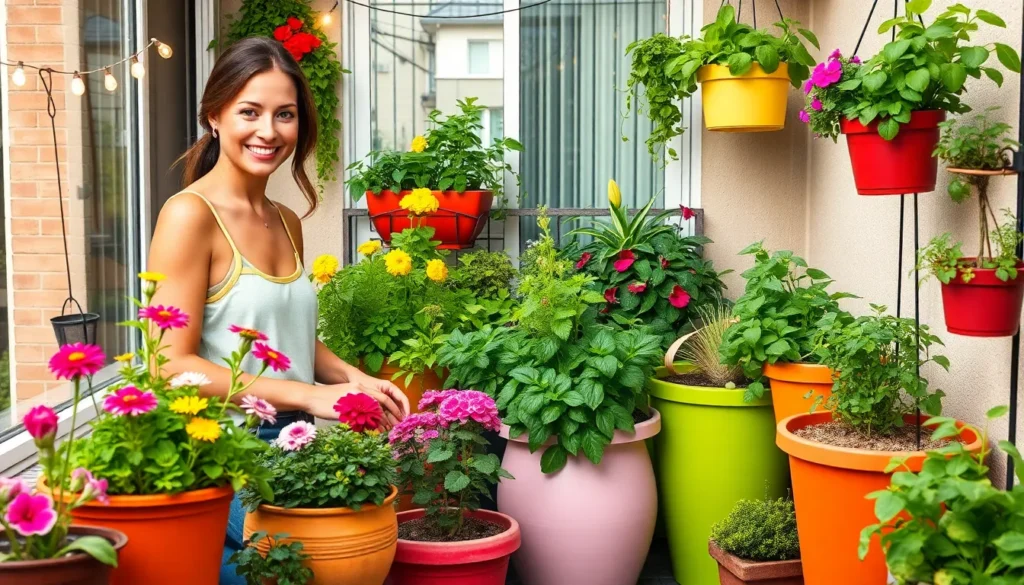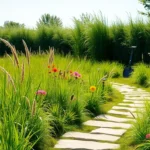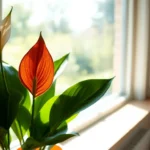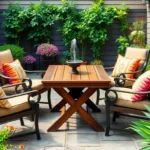We’ve all dreamed of having our own garden oasis but thought we needed a sprawling backyard to make it happen. The truth is you can transform even the smallest balcony into a thriving green paradise that’ll become your favorite escape from daily stress.
Balcony gardening isn’t just about stuffing a few pots in the corner and hoping for the best. It’s about maximizing every square inch of space while creating a beautiful sanctuary that reflects your personality. Whether you’re working with a tiny apartment balcony or a spacious terrace we’ll show you how to grow everything from fresh herbs to stunning flowers.
We’re about to jump into creative answers that’ll turn your outdoor space into an Instagram-worthy retreat. From vertical gardens that climb your walls to clever container arrangements that maximize growing potential these ideas will inspire you to start your balcony transformation today.
Choose the Right Containers for Your Balcony Garden
Selecting appropriate containers transforms your balcony space from cramped to flourishing. We’ve discovered that container choice directly impacts plant health and your gardening success rate.
Vertical Planters and Wall-Mounted Options
Vertical planters maximize growing space by utilizing wall surfaces that typically remain empty. Wall-mounted pocket planters accommodate herbs like basil, mint, and oregano while freeing up floor space for larger plants. Tiered plant stands create multiple growing levels within a compact footprint.
Hanging planters suspend trailing varieties such as cherry tomatoes or strawberries at eye level for easy harvesting. We recommend installing sturdy brackets that support at least 15 pounds per planter to prevent safety hazards. Modular vertical systems allow you to expand your garden as your confidence grows.
Trellis planters combine container growing with climbing support for vegetables like peas, beans, and cucumbers. These dual-purpose containers typically measure 18-24 inches wide and provide adequate root space while supporting vertical growth patterns.
Self-Watering Containers for Low Maintenance
Self-watering systems reduce daily maintenance by storing water in built-in reservoirs that feed plants gradually. These containers feature water gauges that indicate when refilling becomes necessary, typically every 5-7 days during growing season. Sub-irrigation prevents both overwatering and underwatering common mistakes.
Automatic drip irrigation connects multiple containers through tubing systems powered by gravity or small pumps. We’ve found these systems particularly effective for balcony gardens with 6 or more containers. Timer controls deliver consistent moisture levels even during vacations.
Wick watering systems use cotton strings to draw water from reservoirs into soil through capillary action. This passive method works exceptionally well for herbs and leafy greens that prefer consistent moisture levels. Setup costs remain minimal compared to electronic alternatives.
Lightweight Pots and Raised Beds
Fiberglass containers weigh 60% less than ceramic equivalents while providing excellent insulation for root systems. These weather-resistant options withstand temperature fluctuations without cracking or fading. Standard sizes range from 12-inch diameter planters to 4-foot rectangular containers.
Fabric grow bags offer superior drainage and air circulation while weighing just 2-3 pounds when empty. Root pruning occurs naturally as roots reach fabric walls, promoting healthier plant development. We recommend 5-gallon bags for tomatoes and 3-gallon sizes for peppers or herbs.
Raised bed systems create organized growing areas using lightweight aluminum or cedar frames with depths ranging from 8-12 inches. Modular designs allow customization based on available space and plant requirements. Caster wheels enable seasonal repositioning to follow sunlight patterns across your balcony.
Select Plants That Thrive in Small Spaces
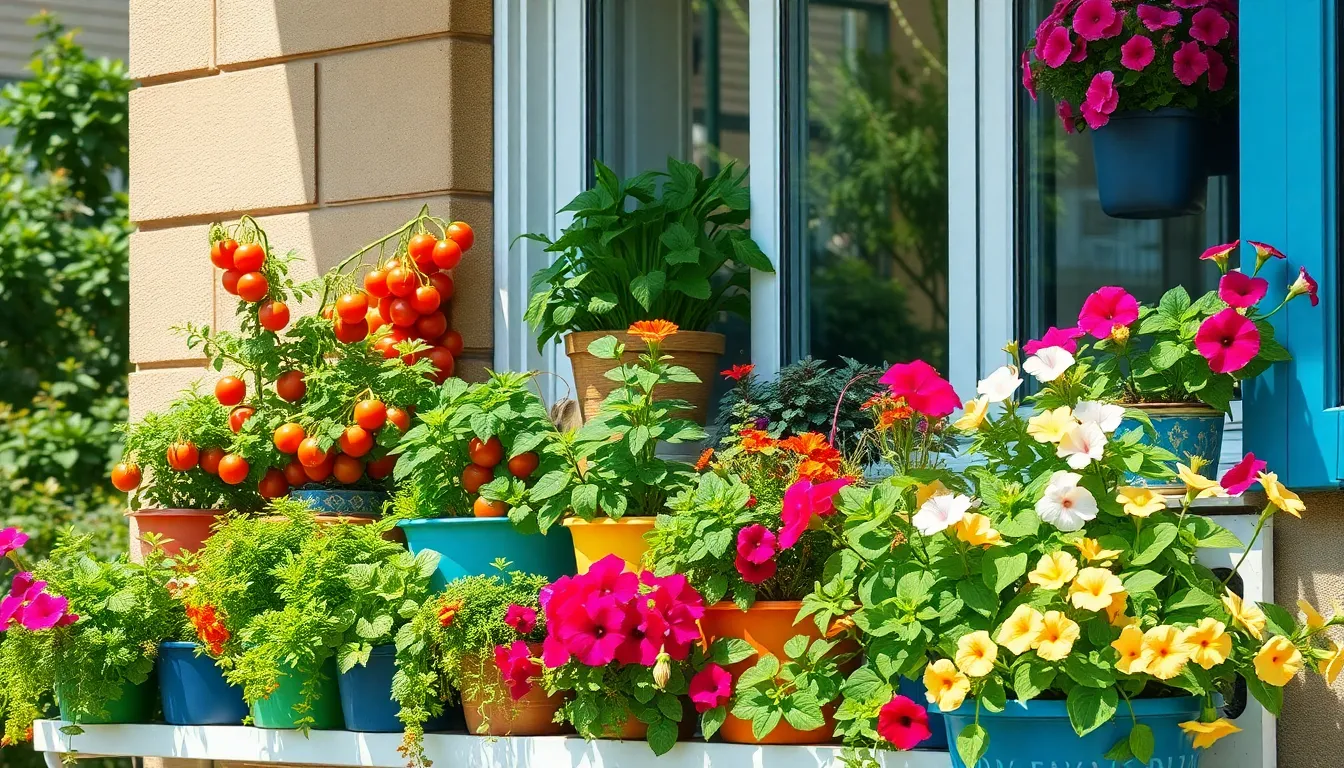
Choosing the right plants transforms your balcony container setup into a thriving garden paradise. We’ll focus on varieties that maximize your growing potential while working within space constraints.
Compact Vegetable Varieties for Urban Growing
Leafy greens like spinach, lettuce, and kale grow exceptionally well in shallow containers and vertical stands. These vegetables require minimal root depth and produce continuous harvests throughout the growing season.
Cherry tomatoes offer abundant yields from compact plants that fit perfectly in medium-sized containers. Dwarf pepper varieties provide colorful harvests while maintaining manageable plant sizes for balcony conditions.
Window boxes create charming displays while housing compact vegetables and herbs along balcony railings. These containers maximize growing space without consuming valuable floor area.
Bush beans and compact cucumber varieties climb trellises efficiently, producing vegetables vertically rather than spreading horizontally across your balcony.
Flowering Plants That Love Container Life
Trailing petunias cascade beautifully from hanging baskets, creating colorful displays that don’t require floor space. These flowering plants bloom continuously with proper care and regular watering.
Container annuals like marigolds and zinnias thrive in sunny balcony conditions, providing vibrant colors throughout the growing season. Perennial options such as lavender and salvia return year after year with minimal replanting effort.
Ferns excel in shaded balcony areas, offering lush green textures that complement flowering varieties. These plants create natural backdrops for more colorful container arrangements.
Geraniums adapt well to container life and tolerate various light conditions, making them versatile choices for different balcony orientations.
Herbs That Flourish on Balconies
Basil grows rapidly in containers and provides fresh leaves for culinary use throughout the growing season. This herb thrives in warm conditions and produces aromatic foliage with regular harvesting.
Cilantro develops quickly from seed and tolerates cooler temperatures better than many other herbs. Fast growing cycles allow for multiple plantings per season in the same container space.
Oregano establishes hardy root systems in containers and returns reliably each year as a perennial herb. This Mediterranean herb tolerates drought conditions and requires minimal maintenance once established.
Mint varieties grow vigorously in containers, which actually helps control their spreading nature. These herbs prefer partial shade and consistent moisture for optimal leaf production.
Maximize Your Space With Vertical Growing Solutions
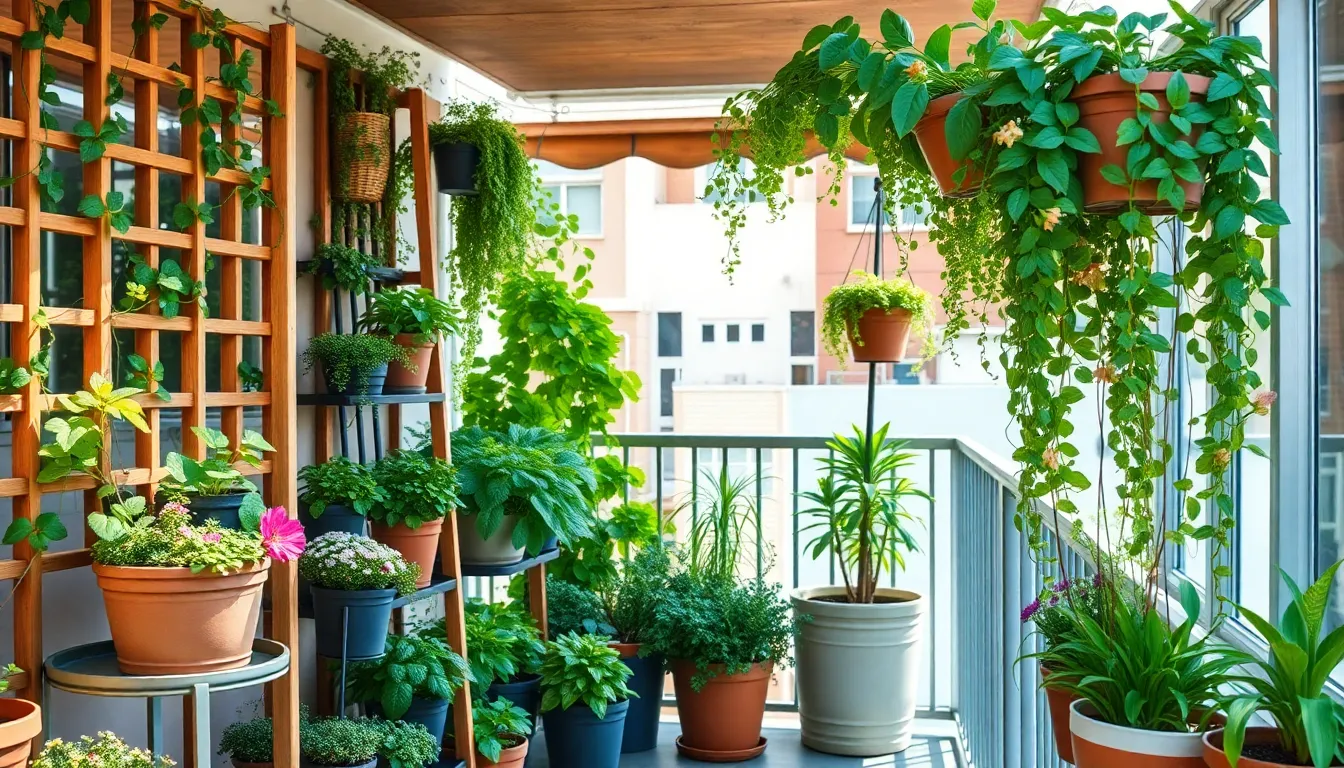
Building upward transforms our balcony gardens into thriving vertical ecosystems that make the most of every square inch.
Trellises and Climbing Plant Systems
Install trellises to create stunning vertical displays that support climbing roses, beans, and flowering vines. These structures add architectural interest while maximizing our growing space without expanding our footprint. We can mount wooden or metal trellises directly against walls or use freestanding versions that divide different areas of our balcony.
Support cages work exceptionally well for heavy producers like tomatoes and cucumbers. Position these wire or bamboo structures around our containers to guide plant growth upward rather than outward. This method keeps fruits and vegetables off the ground while creating impressive vertical displays that can reach 6 feet or higher.
Climbing plant systems utilizing strings or wires offer flexible answers for lightweight vines. We can create simple tensioned wire systems between anchor points to support morning glories, sweet peas, or pole beans that naturally seek vertical support.
Tiered Plant Stands and Shelving Units
Multi level stands allow us to grow different plants at various heights based on their sunlight requirements. We position sun loving herbs like basil and oregano on the top tier while placing shade tolerant ferns and begonias on lower levels. This creates microclimates that accommodate diverse plant needs within our limited space.
Stackable planters offer modular growing answers that we can adjust throughout the season. These interlocking containers work perfectly for herbs, lettuce, and small flowering plants that don’t require deep root systems. We can add or remove levels based on our changing garden needs.
Corner shelving units make excellent use of awkward spaces that might otherwise remain empty. These triangular or curved stands fit perfectly into balcony corners while providing multiple growing levels for our plant collection.
Hanging Gardens and Suspended Planters
Overhead hanging baskets create floating gardens that don’t consume any floor space. We secure these to ceiling hooks or overhead structures to grow trailing plants like strawberries, cherry tomatoes, and cascading flowers. This positioning also makes watering and harvesting more convenient at eye level.
Rail mounted planters clip directly onto our balcony railings to expand our growing area horizontally. These specialized containers work beautifully for herbs, small vegetables, and decorative plants while maintaining easy access from both sides of the railing.
Suspended pocket planters use vertical wall space efficiently by hanging fabric or plastic organizers with multiple planting pockets. We can fill these with herbs, succulents, or small flowering plants to create living walls that transform blank surfaces into productive growing areas.
Create Privacy and Shade in Your Outdoor Oasis
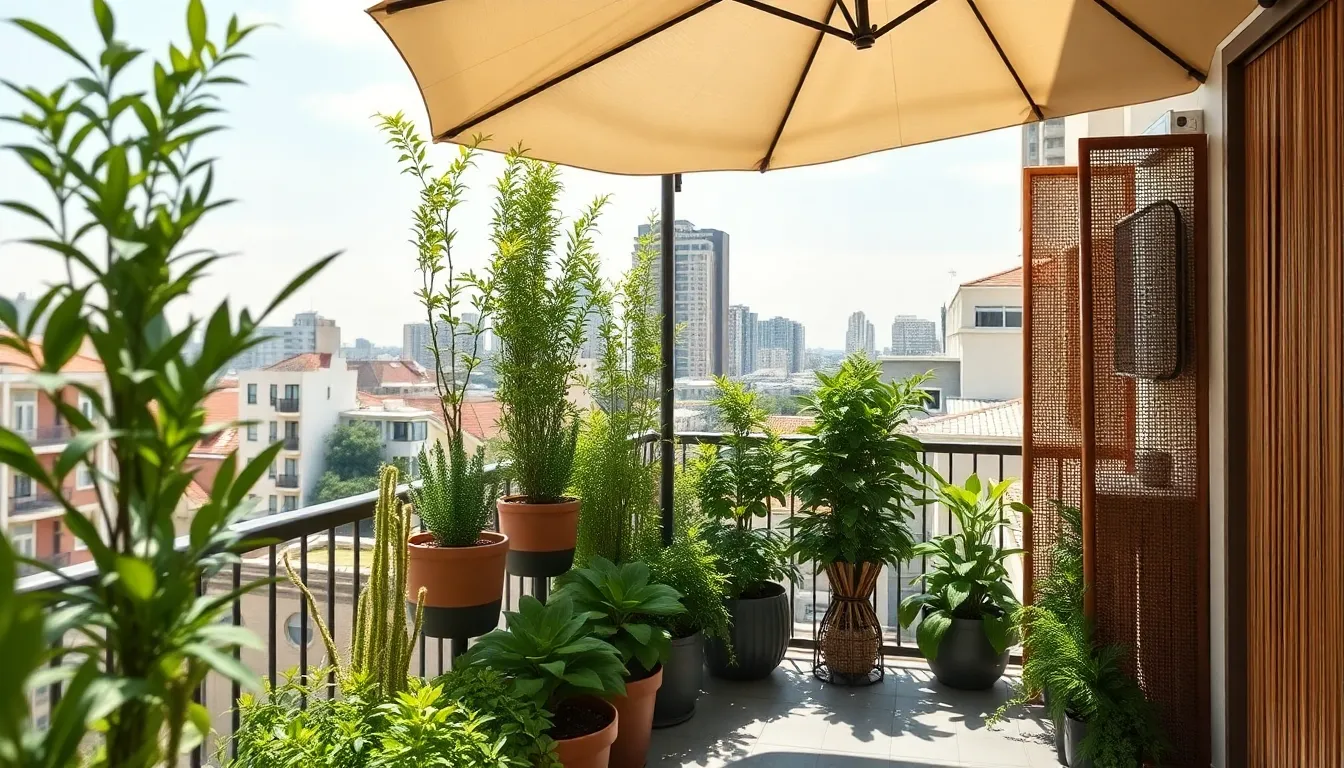
Transform your balcony into a secluded retreat by implementing strategic privacy and shade answers. We’ll explore effective methods to shield your space from prying eyes while protecting plants from harsh sunlight.
Living Privacy Screens With Tall Plants
Tall potted plants offer the perfect natural barrier for your balcony garden sanctuary. Large containers filled with thick shrubs or small trees like palms create an instant privacy screen around your balcony railing. These living walls provide organic screening while maintaining the garden’s aesthetic appeal.
Vertical gardens maximize your privacy potential through strategic plant placement. Modular planters arranged in tiers block unwanted views while creating stunning green displays. Wooden pallets transformed into vertical planters add rustic charm to your screening solution. Hanging plant pockets suspend from walls or ceilings to fill gaps in your privacy coverage.
Shade Cloth and Umbrella Answers
Umbrellas deliver immediate shade protection for compact balcony spaces. Strategic placement creates cool zones where you can relax while protecting sensitive plants from direct sunlight. Adjustable umbrellas adapt to changing sun patterns throughout the day.
Outdoor curtains provide versatile shade and privacy control for your balcony oasis. Roll up curtains made from light fabrics like linen or sheer polyester create a breezy, elegant atmosphere. Blackout versions offer maximum privacy when you need complete seclusion from neighboring balconies. Installation requires minimal hardware while delivering maximum impact.
Bamboo Screens and Natural Barriers
Bamboo screens bring natural elegance to your balcony privacy answers. Cut bamboo panels to precise measurements for a polished, custom appearance that complements your garden aesthetic. These sustainable screens filter light while maintaining airflow around your plants.
Reed privacy screens introduce bohemian style to your outdoor space while providing essential coverage. Reed mats create warm, natural barriers that allow gentle light filtration. These screens maintain privacy without completely blocking beneficial sunlight from reaching your plants.
Natural barriers combine functionality with decorative appeal through strategic design elements. Trellises paired with vertical slatted stands support climbing plants while creating attractive privacy screens. Artificial vines enhance these structures for immediate coverage before natural plants establish. String lights woven through barriers transform privacy answers into enchanting evening displays.
Design a Functional Layout for Daily Enjoyment
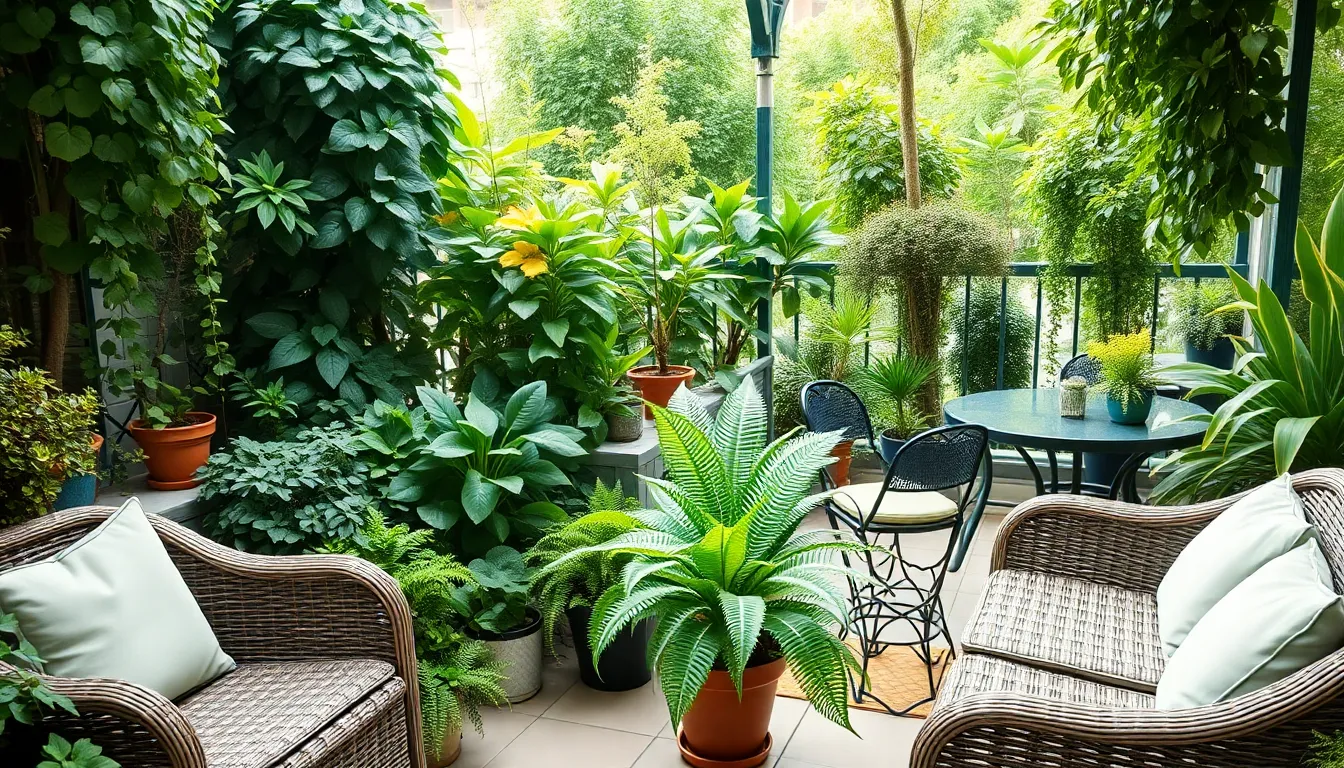
Creating a well-planned balcony garden requires thoughtful organization that serves multiple purposes throughout the day. We’ll maximize your outdoor space by using vertical elements like trellises, shelves, and hanging planters to transform walls and ceilings into productive garden areas.
Zoning Your Balcony for Different Activities
Gardening zones should occupy areas with optimal sunlight and wind protection, using planters of varying sizes to accommodate different plant types. We recommend dedicating the sunniest corner to vegetables and herbs while positioning shade-loving plants like ferns in protected areas.
Relaxation zones create peaceful retreats with comfortable outdoor furniture positioned to overlook your garden displays. Choose weather-resistant seating that complements your plant selections, allowing you to enjoy morning coffee surrounded by greenery.
Entertainment areas work best when space permits, incorporating small dining surfaces or conversation nooks for social gatherings. We suggest using foldable or stackable furniture that can be rearranged based on your daily activities and seasonal needs.
Pathways and Accessibility Considerations
Clear pathways ensure easy movement around your balcony garden without damaging plants or creating safety hazards. We position larger planters along walls and railings, leaving central walkways unobstructed for daily maintenance tasks.
Compact furniture maximizes available space while maintaining accessibility to all garden areas. Foldable chairs and collapsible tables allow you to reconfigure your layout when tending to plants or hosting guests.
Plant arrangement follows a strategic pattern with taller specimens against walls and shorter varieties toward pathways. We place frequently harvested herbs and vegetables within arm’s reach of seating areas for convenient access during meals.
Seating Areas Among Your Garden Space
Integrated seating creates harmony between relaxation and gardening activities by positioning comfortable furniture within plant displays. We recommend wicker or wooden pieces that complement natural garden aesthetics while providing durability against weather exposure.
Strategic placement allows you to enjoy garden views from multiple angles throughout the day. Position seating to face morning sun for breakfast enjoyment, then add moveable options for afternoon shade under larger plants or umbrellas.
Multi-functional furniture serves dual purposes in compact balcony spaces, with storage benches holding gardening supplies while providing comfortable seating. We suggest incorporating side tables near plant groupings for holding beverages, books, or small garden tools during relaxation time.
Install Proper Drainage and Watering Systems
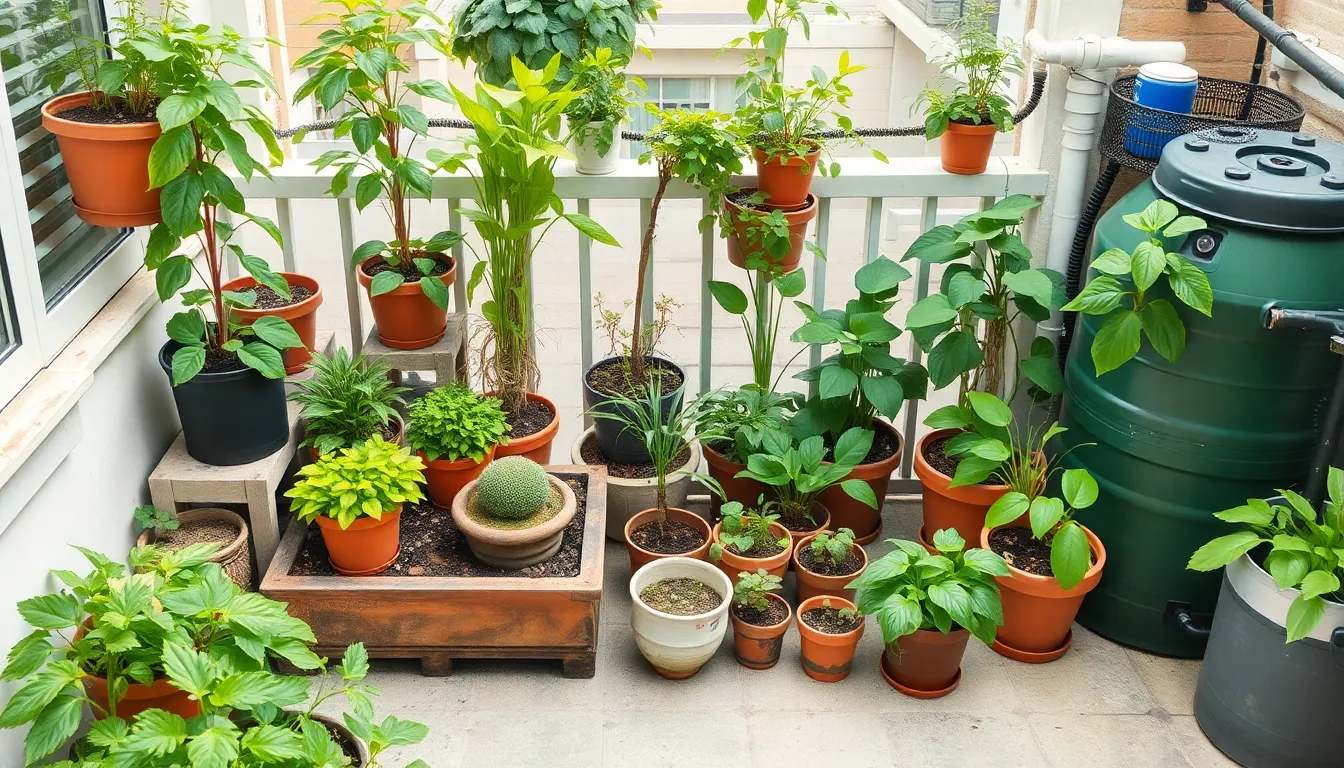
Proper water management forms the foundation of successful balcony gardening. We’ll explore essential drainage answers and efficient watering systems that protect your space while keeping plants healthy.
Drainage Answers to Protect Your Balcony
Adequate drainage holes prevent waterlogged soil and protect both plants and balcony structures. We recommend drilling multiple drainage holes in containers without existing openings, ensuring water flows freely through the bottom. Elevating containers on pot feet or small blocks creates airflow underneath, preventing water from pooling on balcony surfaces.
Drainage layers improve water flow in deeper containers. Adding 2-3 inches of gravel, broken pottery, or expanded clay pebbles at the bottom creates a reservoir that prevents root rot. We suggest using industry fabric over the drainage layer to prevent soil from washing through while maintaining proper water movement.
Drip trays capture excess water without compromising drainage. Placing waterproof saucers under containers protects balcony flooring while allowing us to monitor watering effectiveness. We empty these trays regularly to prevent standing water that attracts pests or creates moisture problems.
Automated Irrigation for Busy Lifestyles
Automated irrigation systems manage watering schedules for consistent plant care. We can program these systems to deliver water at optimal times, typically early morning or evening when evaporation rates are lowest. Drip irrigation systems work particularly well for balcony gardens, delivering water directly to plant roots through small tubes and emitters.
Timer controlled systems provide flexibility for varying schedules. Installing battery operated timers on faucet connections allows us to set multiple watering sessions throughout the day. We adjust timing based on seasonal needs, with longer intervals during cooler months and more frequent watering during summer heat.
Micro sprinkler systems cover larger balcony areas efficiently. These systems distribute water evenly across multiple containers through adjustable spray heads. We position sprinklers strategically to reach all planted areas while avoiding overspray onto balcony furniture or neighboring spaces.
Water Collection and Conservation Methods
Rainwater collection systems conserve water while reducing utility costs. We install collection barrels or tanks under downspouts to capture natural precipitation for irrigation purposes. These systems can store 50-100 gallons of water, providing substantial irrigation supply during dry periods.
Gravity fed systems distribute collected rainwater efficiently. Elevating storage containers allows us to use natural water pressure for irrigation without electricity. We connect simple hose systems with shut off valves to control water flow to different garden areas.
Recycled water from household activities extends our water supply. Collecting water from vegetable washing, air conditioning condensation, or dehumidifiers provides additional irrigation resources. We ensure this recycled water is free from harmful chemicals before using it on edible plants, making our balcony gardens more sustainable and cost effective.
Add Style With Decorative Elements and Lighting
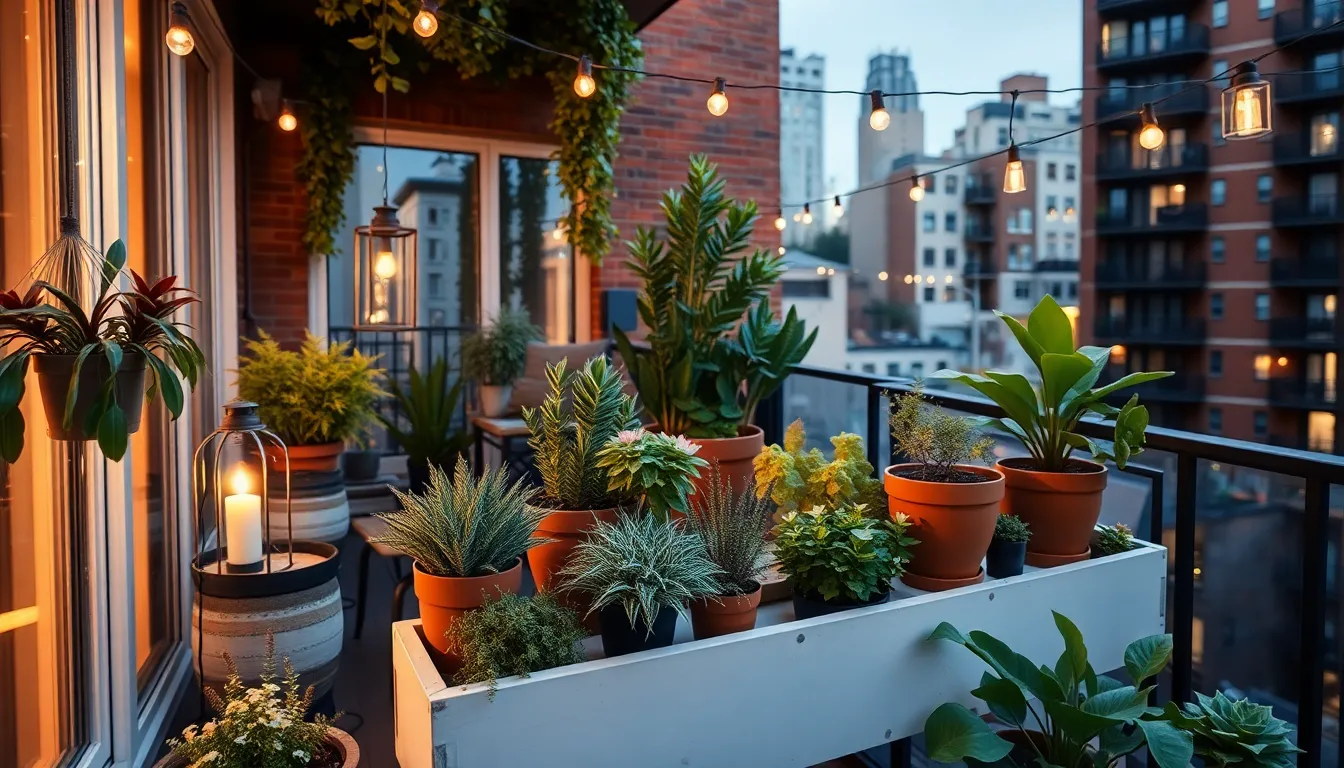
Creating visual appeal extends beyond plant selection to cover decorative touches that transform your balcony into a stunning outdoor retreat. Strategic styling elements help establish personality while functional additions enhance both beauty and usability.
Garden Lighting for Evening Ambiance
String lights create magical evening atmospheres that extend your balcony’s usability well past sunset. We recommend installing weatherproof LED string lights along railings or overhead structures for consistent illumination throughout darker months.
Fairy lights wrapped around plant supports or trellises add whimsical touches that highlight foliage textures after dark. These delicate illumination sources work particularly well with climbing plants like ivy or clematis, creating layered lighting effects.
Solar powered lights offer eco friendly answers that charge during daylight hours and automatically activate at dusk. Position these fixtures strategically around larger planters or along pathway edges to guide movement while showcasing your garden’s best features.
Lanterns and candles provide warm ambient lighting for intimate evening gatherings. Battery operated LED versions eliminate fire hazards while maintaining cozy atmospheres perfect for relaxation zones within your balcony layout.
Decorative Accents and Plant Accessories
Decorative planters serve as functional art pieces that complement your overall design scheme. Choose containers with unique textures, patterns, or finishes that reflect your personal style while providing adequate growing space for your plants.
Sculptures and garden ornaments add focal points that draw attention to exact areas of your balcony garden. Small statues, abstract pieces, or themed decorations create conversation starters while filling empty corners effectively.
Wind chimes introduce gentle sounds that enhance the sensory experience of your outdoor space. Select materials like bamboo or metal that complement your existing decor while providing pleasant auditory elements.
Trellises and slatted walls combine functionality with modern aesthetics by supporting climbing plants while creating architectural interest. These structures work exceptionally well with clematis, morning glories, or jasmine varieties that need vertical support systems.
Plant hangers attached to railings or ceiling hooks maximize growing space while adding playful vertical elements. Use macrame holders, decorative brackets, or modern geometric designs that align with your chosen theme.
Color Coordination and Theme Development
Color schemes should harmonize with your indoor decor to create seamless transitions between interior and exterior spaces. We suggest selecting plant varieties and container colors that echo existing furniture or wall treatments for cohesive design flow.
Mediterranean themes work beautifully with terracotta planters, drought tolerant herbs like rosemary and lavender, and warm earth tone accessories. This approach creates relaxed, vacation inspired atmospheres perfect for urban balconies.
Tropical themes feature bold foliage plants, vibrant flowering varieties, and natural materials like bamboo or rattan accessories. Incorporate palm varieties, colorful bromeliads, and bright ceramic planters to achieve this lush, exotic aesthetic.
Modern minimalist approaches emphasize clean lines, monochromatic color palettes, and geometric planters. Choose architectural plants like succulents or ornamental grasses paired with sleek metal or concrete containers for sophisticated urban appeals.
Seasonal theme rotations allow you to refresh your balcony’s appearance throughout the year. Plan container arrangements and decorative elements that can be easily swapped to reflect spring pastels, summer brights, autumn warmth, or winter elegance.
Maintain Your Balcony Garden Year-Round
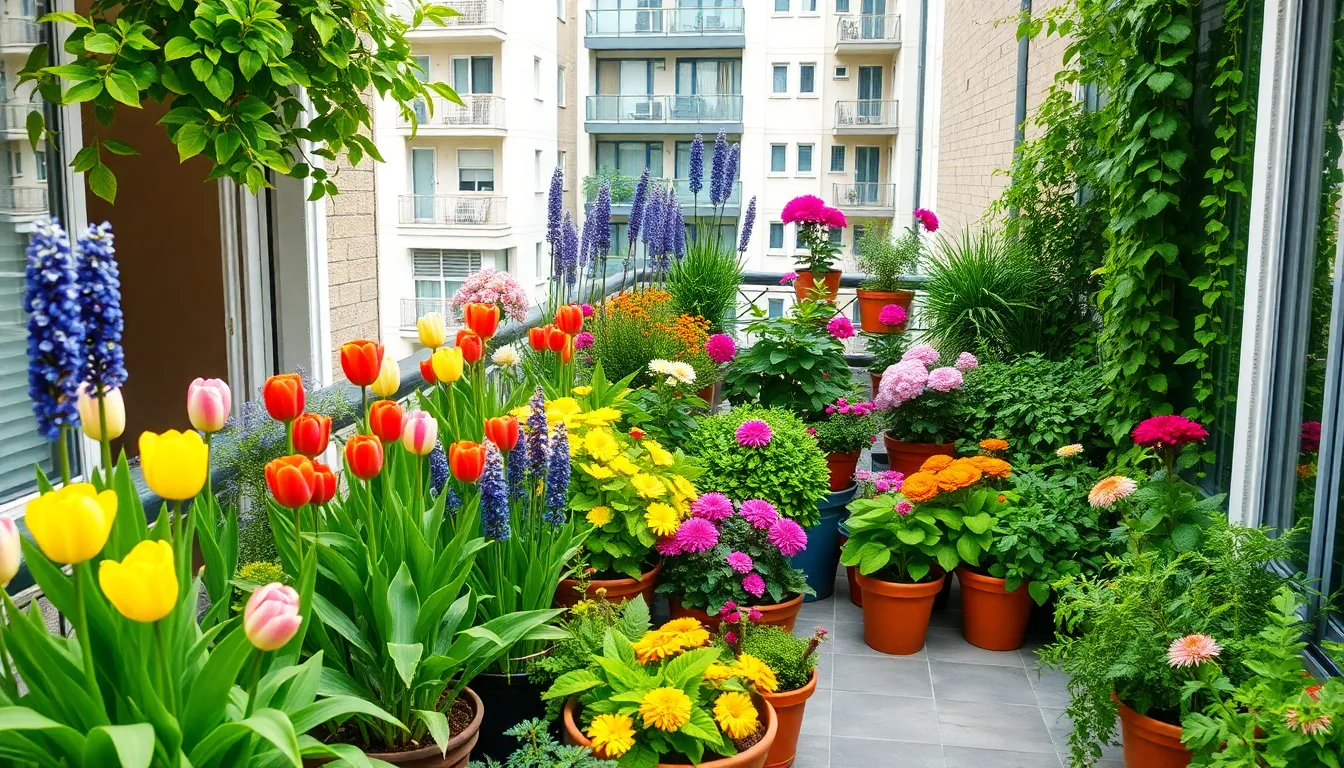
Successful balcony gardening requires ongoing attention throughout every season. We’ll help you develop strategies that keep your plants thriving regardless of weather conditions or time of year.
Seasonal Plant Rotation Strategies
Spring rotation brings vibrant color with tulips and daffodils that signal the start of growing season. These early bloomers create stunning displays while temperatures remain cool and manageable for most container plants.
Summer strategies focus on fragrant plants like lavender and lilies that provide beautiful and scented displays during peak growing months. We recommend positioning these aromatic varieties near seating areas where you’ll appreciate their natural perfume most.
Fall transitions incorporate asters and chrysanthemums that deliver rich autumn colors as daylight hours decrease. These hardy plants extend your garden’s visual appeal well into cooler weather when many summer varieties begin declining.
Winter planning requires evergreen plants and winter blooming flowers like Dwarf Sweet Box to maintain interest during dormant months. Plants of varying heights add visual depth throughout seasonal changes while ensuring year round attraction remains consistent.
Winter Protection and Indoor Alternatives
Thermal protection involves moving vulnerable plants to warmer locations or using specialized covers during freezing temperatures. We suggest monitoring weather forecasts closely and relocating containers before severe cold arrives.
Indoor cultivation becomes essential with self watering planters that minimize maintenance during winter months when outdoor access might be limited. Indoor herb gardens provide fresh ingredients year round while maintaining your gardening routine indoors.
Floor protection requires saucers or trays beneath all indoor containers to prevent water overflow and potential damage. Proper drainage remains critical whether plants stay outdoors or move inside for seasonal protection.
Pest Control in Small Garden Spaces
Natural prevention methods like neem oil and diatomaceous earth effectively control pests without harming beneficial insects that support garden health. These organic answers work particularly well in confined balcony spaces where chemical applications might drift to neighboring areas.
Regular inspection helps identify pest issues and diseases before they spread throughout your compact growing area. We recommend checking plants weekly for unusual spots, holes, or insect activity that signals developing problems.
Early intervention proves most effective in small garden spaces where problems can quickly affect multiple plants due to close proximity. Quick action prevents minor issues from becoming major infestations that could destroy your entire balcony garden investment.
Conclusion
Creating your dream balcony garden is more achievable than you might think. With the right combination of space-saving techniques creative plant selections and thoughtful design choices we can transform even the smallest outdoor areas into thriving green sanctuaries.
Remember that successful balcony gardening isn’t about having endless space—it’s about maximizing what you have. From vertical growing systems to efficient watering answers every element works together to create a functional and beautiful outdoor retreat.
Your balcony garden journey starts with a single plant and grows from there. Whether you’re growing fresh herbs for cooking or creating a colorful flower display the key is to start small and expand as you gain confidence and experience.
Frequently Asked Questions
What containers work best for balcony gardening?
Lightweight containers like fiberglass pots, fabric grow bags, and self-watering planters are ideal for balconies. These options reduce weight load while promoting healthy plant growth. Consider vertical planters and wall-mounted containers to maximize space, and always ensure proper drainage holes to prevent water damage to your balcony structure.
Which plants are best suited for small balcony spaces?
Compact vegetables like cherry tomatoes, leafy greens, and dwarf peppers work excellently in containers. For flowers, choose trailing petunias, marigolds, and geraniums. Herbs like basil, cilantro, oregano, and mint are perfect for beginners as they’re easy to grow and provide fresh ingredients for cooking.
How can I maximize growing space on a small balcony?
Utilize vertical solutions like trellises for climbing plants, tiered plant stands, and hanging planters. Wall-mounted containers and shelving units expand growing areas without consuming floor space. Consider multi-level arrangements and overhead hanging gardens to create more planting opportunities within your limited square footage.
What watering systems work best for balcony gardens?
Self-watering containers and drip irrigation systems are excellent for consistent moisture without overwatering. Install drainage layers and elevate containers for proper airflow. Consider rainwater collection systems and automated timers for efficient water management, especially if you have a busy lifestyle or travel frequently.
How do I create privacy on my balcony garden?
Use tall potted plants like bamboo or ornamental grasses as natural screens. Modular planters can create flexible privacy barriers, while climbing plants on trellises provide living walls. Combine these with outdoor umbrellas or shade cloth for both privacy and sun protection for your plants.
Can I maintain a balcony garden year-round?
Yes, through seasonal plant rotation and proper protection methods. Use spring blooms, summer herbs, fall decorative plants, and winter-hardy varieties. Move sensitive plants indoors during harsh weather, implement frost protection covers, and consider indoor growing alternatives to maintain your garden throughout all seasons.
How do I prevent pests in my balcony garden?
Regular plant inspections and natural prevention methods work best in small spaces. Use companion planting, neem oil treatments, and beneficial insects like ladybugs. Keep the area clean, remove dead plant material promptly, and quarantine new plants before introducing them to prevent pest spread.
What lighting options enhance balcony gardens?
Solar-powered fixtures, string lights, and LED lanterns create beautiful evening ambiance without electrical complications. These options highlight your plants’ beauty while extending your enjoyment time. Choose weather-resistant lighting that complements your garden’s theme and provides adequate illumination for evening plant care.

